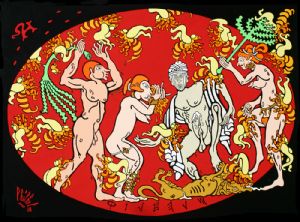| |

|

|
E74 - ATTACK OF THE BEES IN ETRURIA - 2007
Painting Acrylic
Size: 55,1 x 74,8 inches
16800 USD
Description:
ETRUSCAN / Acrylic on canvas 140 x 190 cm or 55,1 x 74,8 inches / (Text translated by Google) / Inspired by Greek Etruscan the reason comes from a black-figure vase now in the British Museum. Gourmet went disturb bees. The scene showing four men, naked, bearded, in the prime of life, attacked on all sides by bees: a man still licking a honeycomb, two other standing waving branches, while a fourth was defending himself squatting arm. Bees do not respect any body part and the artist then has combined the indecent comic focusing on the suffering = Mirko Grmek Dradzen dixit, in: Diseases of Ancient Art, Editions Fayard, 1998. Of the four characters, two have undergone a facelift to become sufficiently serious for women, one is spared from the attack, protected by a providential amulet bee, her chest is taken from Lemi, while the second , apart from the fact that it has changed its location, became totally unrecognizable. The two remaining men, they also changed places and positions while becoming hairless! He was squatting was replaced by ex-satyr, ex, because it is rooted out of a cup with a red face painted by Onesimos 500 BC. J-C. The head has been replaced by that of a patient from a medical treatise prepared by Oribasius in art and how to bandage the wounds of the head! The dog dead or dying, when he and his master -540 was the painter of Inscriptions. The artist's signature appears three times: Etruscan writing, monogrammed and final signature in red on the bottom left!
Black figures: painting technique used by painters of vases. The characters are painted with a varnish to darken when cooked, while the background remains red clay.
Figures red: The opposite of above, the bottom is painted black, the figures are the color of the clay and the details are painted.
Lemi: Monstrous creature Libyan half female, which has experienced the worst punishments attached to a palm tree. Painter of the Shrew 480 BC J-C. visible at the National Museum of Athens. Punishments in the tree were a common practice Etruscan, Italic and Roman!
Satyr: Creature hybrid ape almost always ithyphallic, snub-nosed, with a horse tail and ears.
Oribasius: Famous Greek physician, attached to the Emperor Julian, about 325-403, mostly known for the resumption of treaties antiquity's medicine !
|
|

|
|